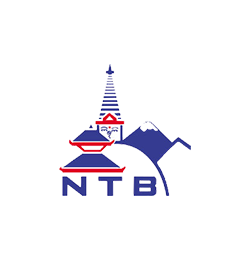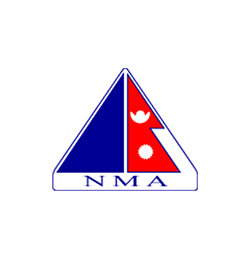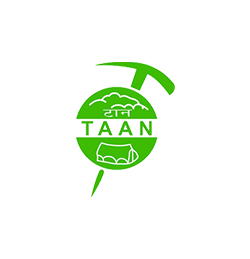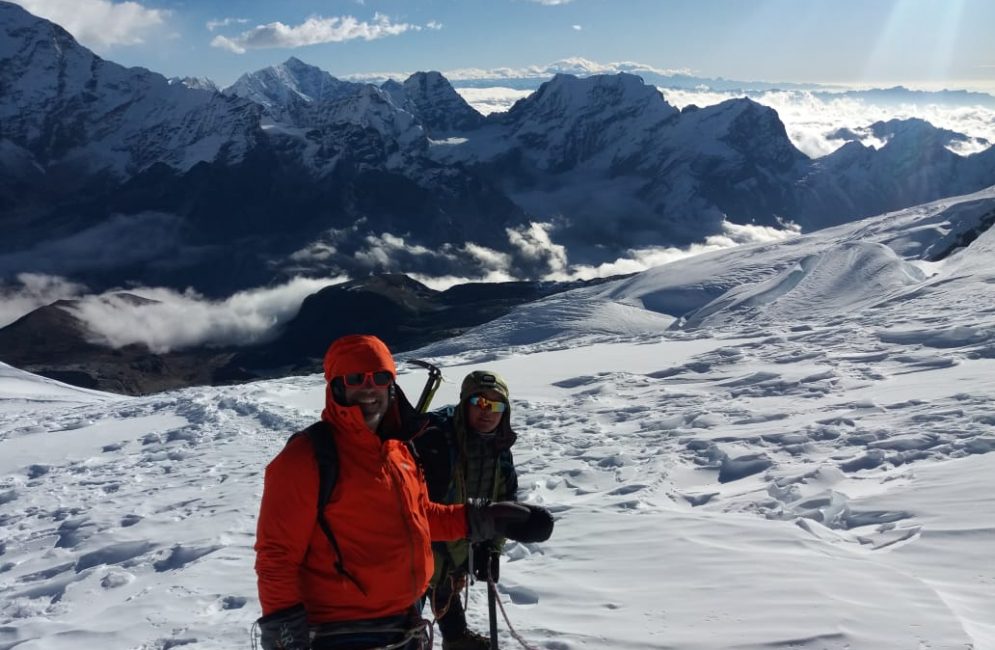
Introduction
Mother Nature has blessed Nepal with eight of the fourteen highest mountains in the world. Home to other hundreds of peaks higher than 6000 meters, Nepal is one of the most preferred destinations for mountaineering and peak climbing.
The Nepal Mountaineering Association (NMA) has identified 1310 peaks suitable for climbing, and 326 are currently open for climbing. Peak climbing is a less technical ascent of mountains peaks between 5600 and 6500 meters that the NMA has graded as trekking peaks or Group B climbing peaks.
Peak Climbing is not highly technical or as strenuous as climbing higher mountains (higher than 7000 m). However, most trekking peaks in Nepal are even higher than some of the highest peaks in Europe, America, and Africa. Therefore, good physical strength, some technical skills, and a tremendous amount of mental courage are expected to accomplish this adventure.
Peak climbing is also the best training opportunity for those aiming for some extreme expeditions in the future. Conquering the trekking peaks of Nepal is undoubtedly an outstanding achievement and a unique experience of mystical value.
Out of many peaks available for climbing, we have sorted out the five most preferred, beautiful, and promising peaks for you.
Mera Peak Climbing
Lying in the remote eastern part of the Khumbu (Everest) region, Mera peak (6461 m) is the highest climbing peak in Nepal. It is the most explored and preferred mountain peak as it offers the unparalleled view of five mountain peaks higher than 8000 meters, including Everest (8848 m). The other four mountains visible from Mera peak are Lhotse, Cho Oyu, Makalu, and Kanchenjunga.
Mera peak climbing is suitable for everyone having good physical fitness and mental determination. It doesn’t require any previous climbing and mountaineering experience. However, it can be a little challenging due to its elevation.
At the base camp (5350 m), you need to spend 2-3 days for necessary training and other preparations. After all the preparations, climb to the high camp (5780 m) and attempt the final ascent. One can complete the ascent in a single day and then descend to the base camp the same day. At the summit, enjoy the incredible view of Mt. Everest and other peaks around you.
Mera peak is one of the best climbing peaks for those who are planning for some higher expedition in the future. Besides, you will also gain the inner strength and motivation to acquire some necessary skills and tactics of climbing useful while attempting a higher peak. Furthermore, as it is in the Everest region, it will familiarize you with the region and introduce you to some of the highest peaks you could aim for in the future.
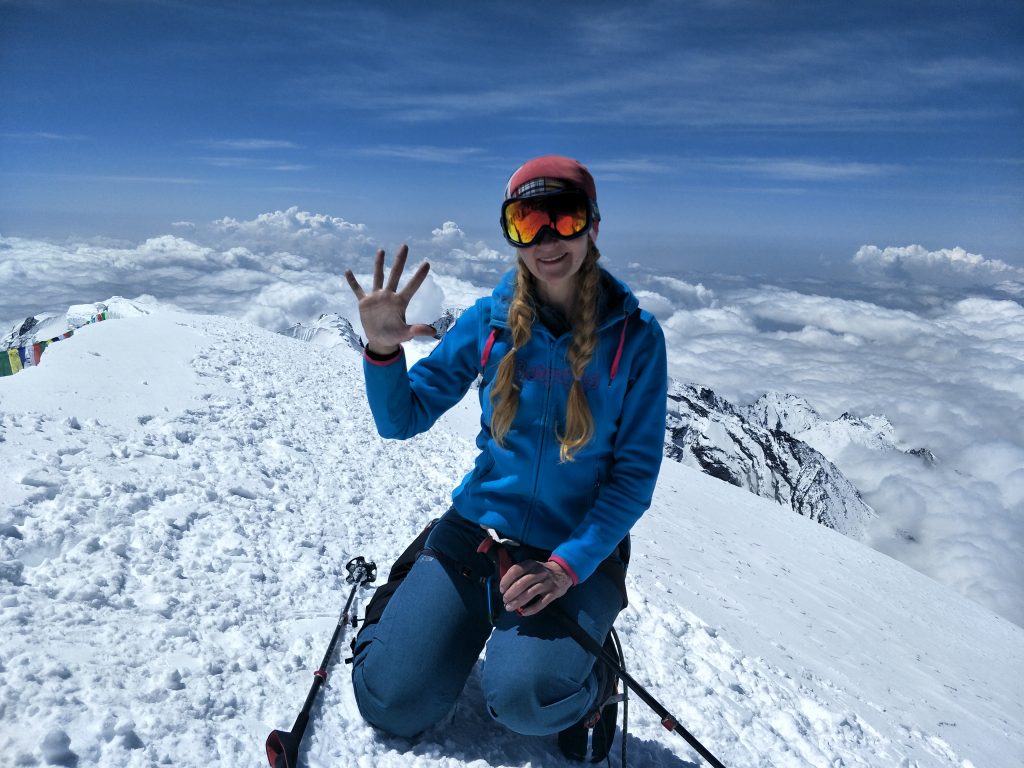
Highlights
- Highest Trekking Peak in Nepal at an elevation of 6461 meters above sea level
- Magnificent view of Mt. Everest and the other four highest peaks
- Straight forward climb and requires no previous climbing experience
- Trek through lush forests, attractive villages, vast pastures, beautiful lakes, and glaciers
Difficulty level
Mera peak climbing is less technical and straight forward climbing requiring no previous climbing experience. However, climbing is a strenuous process. Thus, you need to have good physical fitness and enough determination to complete this daunting task. You can prepare for the peak climbing journey by doing some regular exercises before starting the journey. You need some training, preparation, and days of acclimatization before the final ascent.
Cost of Mera Peak Climbing
The cost of climbing depends on the company you choose and itinerary you follow. However, the general cost ranges from USD 2100 to 2500. Permit costs issued by NMA differ from season to season. Currently, it is USD 250 for spring, USD 125 autumn, and USD 70 for winter and summer for a group of up to four people.
Island Peak Climbing
Island peak (6189 m), also known as Imja Tse Peak, is an impressive trekking peak in the Everest region. The Peak got its name as “Island peak” because of its phenomenal view from Dingboche. The Peak, when seen from Dingboche, looks like an island floating on the sea of ice. Island peak lies in Imja valley, which is known for its incredible landscapes and mighty glaciers.
Imja peak has an impressive and highly glaciated west face rising from Lhotse Glacier. It is the extension of Mt. Lhotse and Mt. Everest. It is one of the difficult peaks among the climbing peaks in Nepal. The climb is difficult across the ridge, ice, and snow. However, the challenge is worth the fantastic view it offers. One can relish the wonderful view of Mt. Amadablam (6856 m) and Mt. Makalu (8481 m) from its top.
The key to a successful peak climb is proper training and an adequate amount of acclimatization. Island peak climbing itinerary is designed meticulously, allowing you enough days for acclimatization on the way to the base camp (5500 m). The first acclimatization is at Namche Bazar, followed by two others at Periche and Dingboche.
The trekking trail to Island Peak is common to the Everest Base Camp trail, and you will climb to Kalapatthar and Everest Base Camp. Kalapatthar is the highest point of the Everest Base Camp Trek, from where you can enjoy the most magnificent view of Mt. Everest.
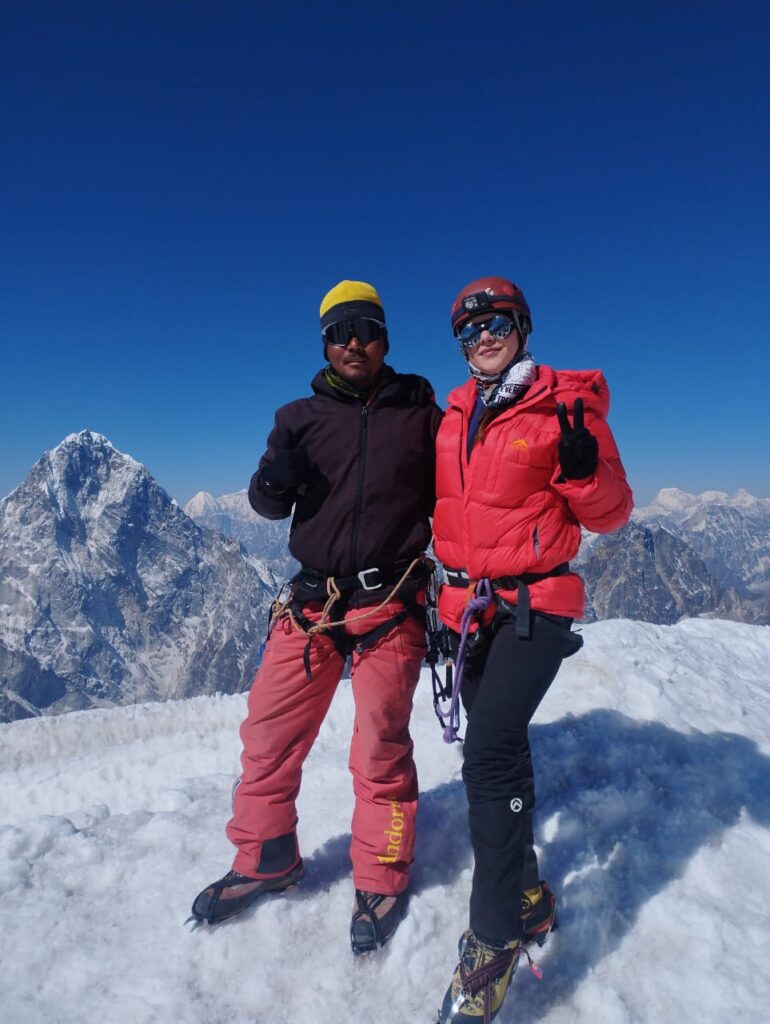
Highlights
- Unparalleled view of Mt. Everest from Kalapatthar
- Amazing view of Mt. Amadablam and Mt. Makalu from the top of the Island peak
- Trek through beautiful villages, forests, rocky ridges, and glaciers
- Excellent opportunity to learn necessary climbing skills and gain mountaineering experience
Cost of Island Peak Climbing
Island peak is a climbing Peak (category B) for which the permit cost is USD 250 for spring, USD 125 for autumn, and USD 70 for winter and summer. The overall cost depends on many factors, including the travel company you choose, the itinerary you take, and the accommodation you choose. Nepalese travel companies generally charge around USD 2000 to USD 2500 per person for a group of 5-10 people.
Difficulty level
Although considered difficult among the trekking peaks in Nepal, Island peak climbing is a moderate climbing peak. You don’t need any previous climbing experience and high technical skills for this peak climbing. Nevertheless, those having some abseiling skills and climbing techniques will have the privilege of climbing with ease. If it is your first time in the mountain, start some training before you fly to Nepal.
Chulu West Peak Climbing
Located in the Manang district, Chulu West Peak (6419) is a moderate climbing peak in the beautiful Annapurna region. Its location, moderate technical sections, and average elevation have made it one of the best trekking peaks in the Annapurna region. A group of Japanese Expeditioners first climbed Chulu West Peak in the year 1953.
Chulu Peak is known for the great panoramic view from its top. You can see the unusual landscape of Tibet in the north, whereas in the south, you can have the astounding view of Mt. Annapurna II, III, IV, Manaslu, Dhaulagiri, Nilgiri, and many other mountain peaks. On your descent, you come across one of the highest passes in Nepal, the Thorong La Pass (5416 m).
Chulu Peak offers an exciting climb for both first-timers as well as experienced climbers. The novice climbers can also easily conquer the Peak, but you need to have good physical fitness and enough mental strength. Another important factor for the successful summit is proper acclimatization. The climb is straight forward. However, there are some technical sections where you might need certain climbing skills. Therefore, you need to stick to the instructions of your guide while climbing.
The trek to Chulu West Peak begins from Besisahar Lamjung and follows the wonderful Annapurna circuit. The trail takes you through the attractive Gurung villages, beautiful pine, fir and rhododendron forests, wonderful lakes, clear streams and rivers, impressive Buddhist monasteries, vast pasture lands, and moraines of icy glaciers.
Highlights
- Trek through the wonderful Annapurna Circuit
- Experience the culture and hospitality of the Gurung people
- Enjoy the astounding views of Annapurna, Dhaulagiri, Nilgiri, and Manaslu from the summit of Chulu West peak
- Come across Thorong La Pass, one of the highest mountains passes in Nepal
- Visit Muktinath and Mustang, the land of incredible dry landscapes
Difficulty level
Chulu West peak is a moderate climbing peak. However, there are some technical sections where you might need certain climbing skills. But you don’t need to worry as even a novice climber with good physical fitness and great mental strength can do it. You need to have proper acclimatization during the trek days and some training before the final ascent. Your determination and the instructions of our trained guides will help reach the top of the Peak.
Cost of Chulu West Peak Climbing
The permit cost for the Chulu West peak is USD 250 for spring, USD 125 for autumn, and USD 70 for summer and winter. The overall cost depends upon the company you choose and the number of people in your team. Foreign companies may charge as high as USD 4000, but Nepalese companies charge around USD 2800 for a group of 5-10 people.
Pisang Peak Climbing
Pisang peak (6091 m) is an attractive pyramidal peak in the Annapurna region. It is tucked between two giant peaks of Annapurna I and Manaslu, which are higher than 8000 meters. The Peak rises opposite of Mt. Annapurna and looks like a watchful guardian above the village of Pisang.
A German expedition team first climbed the Peak in 1955. The Peak offers an astonishing view of Annapurna, Manaslu, Lamjung, Khangra, Gangapurna, Tilicho, and many other peaks in the Annapurna region. From the top of the Peak, one can view the Tibetan plateau in the north, whereas the snow-clad mountain peaks in the south.
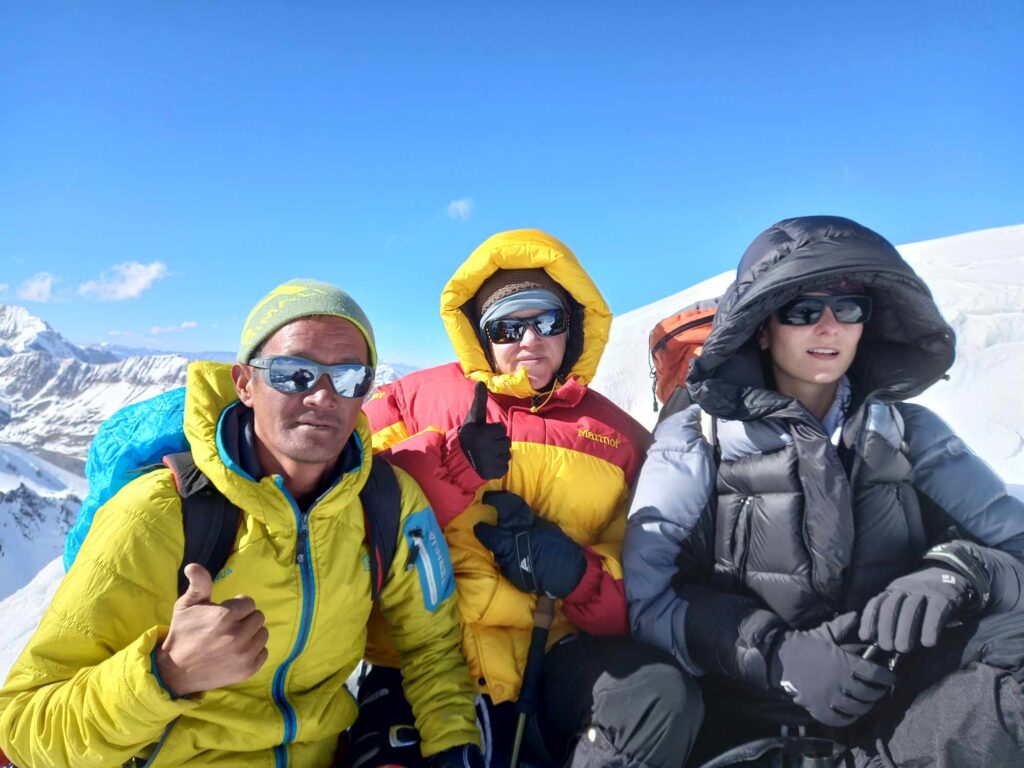
The base camp is usually set up at Kharka (4830 m), and the high camp is set up on the southern ridge at the height of 5400 m. Pisang Peak is a moderate climbing peak. However, certain sections are a bit technical and require some climbing skills and expertise. Especially, the final stretch to the summit is somewhat steep, requiring considerable effort and precautions. The technicalities involved in climbing has made Pisang a preferable choice for those aiming for tough expeditions in the future.
The trek to the Pisang peak follows the beautiful Annapurna Circuit. It starts in the terraced paddy fields at Dharapani. After descending from the Peak, you come across the Thorong La Pass to enter Mustang. Thus, the Pisang peak climbing trek combines the majestic beauty of two Himalayan valleys of Manang and Mustang.
Highlights
- Excellent view of Annapurna, Manaslu, and many other mountain peaks
- Chance to acquire necessary climbing skills and technical expertise while making the ascent
- Discover the wonderful valleys of Manang and Mustang
- Trek through the diverse landscapes and unique culture
- Come across the high pass of Thorong La.
Difficulty level
Pisang peak climbing is a moderate climb and doesn’t require previous climbing experience. However, some sections are little technical. Therefore, you need some training at the base camp, and you need to follow the instructions strictly. Acclimatization is included in the itinerary, which helps you adapt to the atmosphere of higher altitude. Maintain good health as you start some exercises to keep you physically and mentally strong.
Cost of Pisang Peak Climbing
The permit cost for the Pisang peak is USD 250 for spring, USD 125 for autumn, and USD 70 for summer and winter. The overall cost depends upon the company you choose and the number of people in your team. Travel companies in Nepal charge around USD 2800 for a group of 5-10 people.
Tent Peak Climbing
Tent Peak, also known as Tharpu Chuli, is one of the lowest trekking peaks in Nepal at an elevation of 5663 m. The Peak has got its name “Tent peak” because of the shape of its top that resembles the shape of a tent. This beautiful Peak is located in the Annapurna Sanctuary, south of Annapurna Base Camp.
The Peak is in the middle of the amphitheater surrounded by several mountains in the Annapurna massif. One can enjoy the panoramic view of the astounding mountain peaks of Annapurna I, Annapurna South, Himchuli, Khangsar, Gangapurna, and Machhapuchhre from the summit.
Tent peak climbing is a moderate climb and is considered easier than other trekking peaks. However, you need to have good physical fitness and mental determination. Moreover, you need proper acclimatization and some training. Tent Peak is best for those who are taking their first steps in the vast adventure of climbing and mountaineering.
Tent Peak climbing combines the Annapurna circuit trek in its itinerary. The trek begins in the lowland rice terraces at Nayapul and then takes you through the quaint villages and thick forests. As you climb higher and make a loop around the region to the northern side, the terrain becomes rough and dry. This dramatic change of landscape within a short elevation is one of the peculiar features of this climbing trek. The trek finally takes you to Annapurna Base Camp from where we head south along the icy trail to reach Tent Base Camp.
Highlights
- Enjoy the magnificent view of Annapurna, Machhapuchhre, Himchuli, Gangapurna, and others in the Annapurna Massif from the top of the Peak
- Experience the dramatic landscapes of the Annapurna Sanctuary
- Savor the mesmerizing view of the sunrise over the Himalayas from Poon Hill
- Peek into the lifestyle and culture of the ethnic Gurung people
Difficulty level
Tent peak climbing is a moderate climb and considered easier than other trekking peaks such as Mera, Yala, and Island Peak. However, you need to have good physical fitness coupled with a strong mental determination to climb the Peak successfully. You can start doing some regular cardio exercises before flying to Nepal.
Cost of Tent Peak Climbing
The cost of climbing varies according to travel companies and the number of members in a team. The permit cost for a team of up to four members is USD 350. The general cost per person is around USD 2000 for a group of 2-5 people and around USD 1800 for a group of 6-10 people.
Key Information on Peak Climbing in Nepal
- There are 1310 peaks identified for climbing in Nepal, of which 326 are currently open for climbing.
- Peak climbing involves a less technical ascent of peaks lower than 7000 meters.
- Nepal Mountaineering Association of Nepal grades those peaks as Trekking peaks or Group B Climbing peaks.
- Climbing peaks in Nepal are higher than some of the highest mountains in Europe, America, and Africa.
- One must acquire their respective climbing permit from NMA.
- You need to pay a royalty to climb a peak. However, some of the peaks are royalty-free.
- A license holder Nepali guide is a must for climbing any peak.
- You need to stick to the rules and restrictions imposed by Nepal Government for Peak Climbing.
- You need to spend 2-3 days at the Base Camp for necessary training and acclimatization.
- Acclimatization is mandatory in peak climbing to avoid any kind of Altitude Sickness.
- The final ascent can be done in a single day, depending on the weather conditions.
- Schedule enough time for multiple attempts as the weather in the mountains is unpredictable.
- The best season for Peak Climbing in Nepal is spring (March-May) and Autumn (October-November).
- You have to manage your climbing gear, which you can either bring from your home country or buy/rent in Kathmandu.
Conclusion
Peak climbing is an adventurous journey in the wonderlands of the Himalayas. For those aiming at the higher mountains, the peaks, as mentioned earlier, are the perfect choices. This novel experience not only takes you to the top of some exciting mountain peaks but introduces you to the culture and nature of Nepal at every step throughout the trek.

